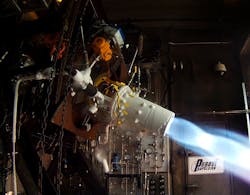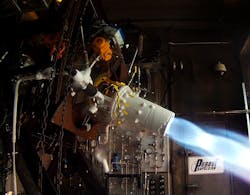Students Test-Fire Rocket Engine Component They Built for NASA
Engineering students at Purdue University recently test fired a thrust chamber they designed and built as part of NASA’s Project Morpheus. The goal of the project is to develop a spacecraft that can autonomously take off and land vertically. (To see a video of a prototype of the spacecraft, click here.) Students have been working on the chamber since 2010 when it began as a senior design project.
The final engine will need to be lightweight if it is to be used on moon and Mars landings. So the students gave the thrust chamber (or combustor) relatively thin walls. But this means the chamber walls will have to be well cooled to prevent them from melting as temperatures inside reach 5,000°F for up to 2 min as the engine fires. When completed, the engine will generate 1,300 to 4,200 lb of thrust. Tests done on the chamber are to determine cooling needs.
The student team also developed a subsystem that liquefies the methane fuel. This lowers the cost and difficulty of transporting and using methane gas.

